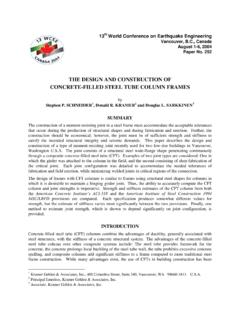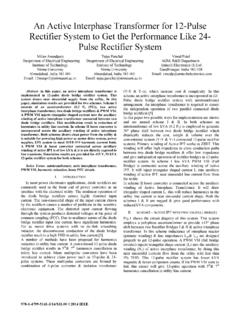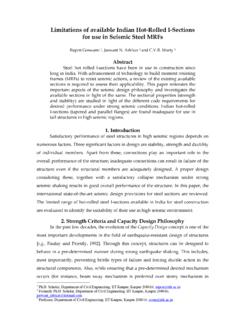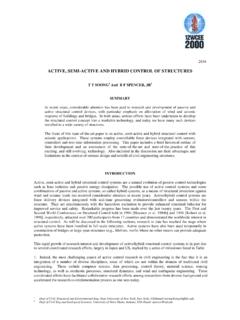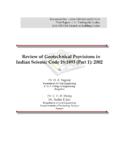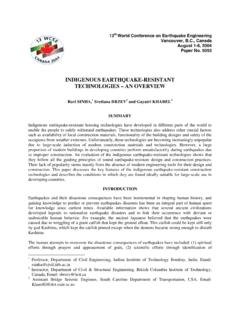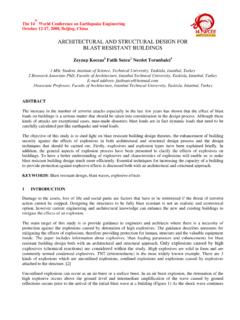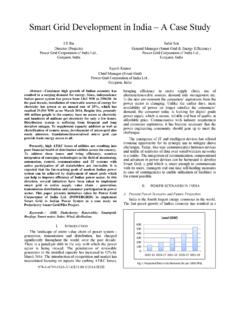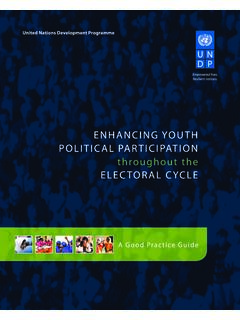Transcription of HANDBOOK - iitk.ac.in
1 Towards a new dawn Government of IndiaMinistry of women and Child Development November 2015 HANDBOOKOnSexual Harassment of women at Workplacefor Employers / Institutions / Organisations/Internal Complaints Committee / Local Complaints Committee(Prevention, Prohibition and Redressal) Act, 2013 HANDBOOK on Sexual Harassment of women at Workplace (Prevention, Prohibition and Redressal) Act, 2013for Employers / Institutions / Organisations/Internal Complaints Committee / Local Complaints CommitteeGovernment of IndiaMinistry of women and Child Development November 2015 ContentsSECTION 1: INTRODUCTION 1 THE MANDATE 3 THE GENESIS 3 THE ACT 4 PURPOSE OF THIS HANDBOOK 5 WHO IS THIS HANDBOOK FOR? 5 STRUCTURE OF THE HANDBOOK 5 SECTION 2: WORKPLACE SEXUAL HARASSMENT- WHAT IS IT?
2 7 WHO IS AN AGGRIEVED WOMAN 7 WHAT IS A WORKPLACE? 8 WHAT IS SEXUAL HARASSMENT AT WORKPLACE? 9 KEY ELEMENTS OF WORKPLACE SEXUAL HARASSMENT 9 EXAMPLES OF BEHAVIOURS AND SCENARIOS THAT CONSTITUE SEXUAL HARASSMENT 12 FORMS OF SEXUAL HARASSMENT 14 SCENARIOS 14 SECTION 3: PREVENTION & PROHIBITION 18 PREVENTIVE AUTHORITIES 18 WHO IS A DISTRICT OFFICER (DO)? 19 RESPONSIBILITIES OF THE AFOREMENTIONED AUTHORITIES 19 SECTION 4 : REDRESS 23 WHO CAN COMPLAIN AND WHERE? 23 WHAT SHOULD THE COMPLAINT CONTAIN? 24 WHAT CAN AN EMPLOYEE/WORKER EXPECT? 24 KEY RESPONSIBILITIES 25 KNOWLEDGE, SKILLS, TRAINING 25 DO S AND DON TS FOR COMPLAINTS COMMITEE 26 NON-NEGOTIABLES DURING THE INQUIRY PROCESS 27 THE SEXUAL HARASSMENT COMPLAINT PROCESS 27 AT A GLANCE 34 SECTION 5: MONITORING 37 SECTION 6: GLOBAL NORMS AND GOOD PRACTICES 39 The meaning and content of the fundamental rights guaranteed in the Constitution of India are of sufficient amplitudes to encompass all facets of gender Late Chief Justice Verma, Supreme Court of India, Vishaka v.
3 State of RajasthanIntroduction Whereas sexual harassment results in violation of the fundamental rights of a Woman to [Preamble, Sexual Harassment of women at Workplace (Prevention, Prohibition & Redressal) Act]SECTION 1As enshrined in the Preamble to the Constitution of India, equality of status and opportunity must be secured for all its citizens; equality of every person under the law is guaranteed by Article 14 of the Constitution. A safe workplace is therefore a woman s legal right. Indeed, the Constitutional doctrine of equality and personal liberty is contained in Articles 14, 15 and 21 of the Indian Constitution. These articles ensure a person s right to equal protection under the law, to live a life free from discrimination on any ground and to protection of life and personal liberty.
4 This is further reinforced by the UN Convention on the Elimination of all Forms of Discrimination against women (CEDAW), which was adopted by the UN General Assembly in 1979 and which is ratified by India. Often described as an international bill of rights for women , it calls for the equality of women and men in terms of human rights and fundamental freedoms in the political, economic, social, cultural and civil spheres. It underlines that discrimination and attacks on women s dignity violate the principle of equality of harassment constitutes a gross violation of women 's right to equality and dignity. It has its roots in patriarchy and its attendant perception that men are superior to women and that some forms of violence against women are acceptable.
5 One of these is workplace sexual harassment, which views various forms of such harassment, as harmless and trivial. Often, it is excused as natural male behaviour or harmless flirtation which women enjoy. Contrary to these perceptions, it causes serious harm and is also a strong manifestation of sex discrimination at the workplace. Not only is it an infringement of the fundamental rights of a woman, under Article 19 (1) (g) of the Constitution of India to practice any profession or to carry out any occupation, trade or business ; it erodes equality and puts the dignity and the physical and psychological well-being of workers at risk. This leads to poor productivity and a negative impact on lives and livelihoods. To further compound the matter, deep-rooted socio-cultural behavioural patterns, which create a gender hierarchy, tend to place responsibility on the victim, thereby increasing inequality in the workplace and in the society at large.
6 12 HANDBOOK on Sexual Harassment of women at WorkplaceThough sexual harassment at the workplace has assumed serious proportions, women do not report the matter to the concerned authorities in most cases due to fear of reprisal from the harasser, losing one s livelihood, being stigmatized, or losing professional standing and personal reputation. Across the globe today, workplace sexual harassment is increasingly understood as a violation of women 's rights and a form of violence against women . Indeed, the social construct of male privileges in society continues to be used to justify violence against women in the private and public sphere. In essence, sexual harassment is a mirror reflecting male power over women that sustains patriarchal relations.
7 In a society where violence against women , both subtle and direct, is borne out of the patriarchal values, women are forced to conform to traditional gender roles. These patriarchal values and attitudes of both women and men pose the greatest challenge in resolution and prevention of sexual harassment. Workplace sexual harassment, like other forms of violence, is not harmless. It involves serious health, human, economic and social costs, which manifests themselves in the overall development indices of a Sexual Harassment of women at Workplace (Prevention, Prohibition and Redressal) Act, 2013 was enacted to ensure safe working spaces for women and to build enabling work environments that respect women s right to equality of status and opportunity.
8 An effective implementation of the Act will contribute to the realization of their right to gender equality, life and liberty, equality in working conditions everywhere. The sense of security at the workplace will improve women s participation in work, resulting in their economic empowerment and inclusive growth. The full scale of the problem is not known given the difficulties in documenting the experience of those who have experienced workplace sexual harassment. However, available studies on sexual harassment show that it is certainly prevalent in India today. This is why the legislation is an important step forward within the larger architecture of women s rights, as it tackles this issue to secure the rights of women workers across the country.
9 While the official figures for women s work participation are low, much of the work that women do is not captured in official data accounts. It is argued1 that where this is to be captured, women s overall work participation would be per cent. While the official data2 shows that women s work participation rate is around per cent in rural areas and per cent in the urban areas, estimates indicate that there is a huge workforce of women , therefore there is a need to secure their workplace and entitlements. Given, that 93 per cent of women workers are employed in the informal sector, they remain unprotected by laws. With no laws or mechanisms to protect them, proactive measures are required to make their workplaces safe. 1 Professor Jayati Ghosh, Paper on What Exactly is Work?
10 NSSO 2011-123 HANDBOOK on Sexual Harassment of women at WorkplaceIt is well established that ensuring safe working conditions for women leads to a positive impact on their participation in the workforce and increases their productivity, which in turn benefits the nation as a whole. Economically, empowered women are key to the nation s overall development and this can only be achieved if it is ensured that women s workspaces across all sectors and all over the country have a safe and secure environment for is important as well to ensure that the emphasis is on prevention rather than punitive action. This calls for widespread awareness on the Act among employers, managers and the workers themselves. Frequently, women workers may face sexual harassment but may not be aware that it is a breach of their rights and that there is something they can do about it.

